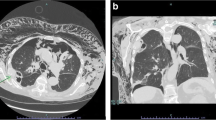Abstract
The pulmonary deposition and pharmacokinetics of insulin, administered via an endotracheal tube as an aerosol and instillate, in formulations containing either 113mIn-DTPA or 99mTc-DTPA (for gamma scintigraphic imaging) have been studied in four male New Zealand White rabbits. Using a randomized crossover design, the pharmacokinetics of intravenous insulin were also characterized. Recovery of immunoreactive insulin after nebulization was greater than 90%, indicating that the aerosolisation procedure did not cause appreciable insulin degradation. Gamma scintigraphy demonstrated that the penetration index (peripheral:central deposition) for the aerosolized formulation (1.52) was much greater than that for the instillate (0.32). Gamma scintigraphy also allowed exact quantification of the dose deposited after aerosol administration and thus permitted accurate determination of bioavailabilities. The bioavailable fraction for aerosolized insulin was 10-fold greater than for instilled insulin (57.2 vs 5.6%). Mucociliary clearance was likely to be greater for the instillate since it showed a preferential central deposition; this may account for the lower bioavailability. Insulin pharmacokinetics from both pulmonary formulations were absorption rate limited, resulting in postpeak half-lives which were approximately 20-fold greater than the intravenous elimination half-life (3 min). The apparent absorption rate constants resulting from instillation and aerosolisation were statistically equivalent (0.015 and 0.011 min−1, respectively). Mucociliary clearance of insulin would result in an overestimation of the true absorption rate constant; hence if mucociliary transport were greater for the instillate, then the true airways to blood transfer rate constant will be higher for the aerosolized formulation.
Similar content being viewed by others
REFERENCES
J. D. Brain, D. E. Knudson, S. P. Sorokin, and M. A. Davis. Pulmonary distribution of particles given by intratracheal instillation or by aerosol inhalation. Environ. Res. 11:13–33 (1976).
J. D. Brain and P. A. Valberg. Deposition of aerosol in the respiratory tract. Am. Rev. Respir. Dis. 120:1325–1373 (1979).
R. A. Brown and L. S. Schanker. Absorption of aerosolized drugs from the rat lung. Drug Metab. Dispos. 11:355–360 (1983).
L. S. Schanker, E. W. Mitchell, and R. A. Brown. Species comparison of drug absorption from the lung after aerosol inhalation or intratracheal injection. Drug Metab. Dispos. 14:79–88 (1985).
A. B. Dennis, S. J. Farr, I. W. Kellaway, G. Taylor, and R. Davidson. In vivo evaluation of rapid release and sustained release Gelucire capsule formulations. Int. J. Pharm. 65:85–100 (1990).
M. Rowland and T. N. Tozer. Clinical Pharmacokinetics: Concepts and Applications, Lea and Febiger, Philadelphia, 1989.
K. K. L. Ho, I. W. Kellaway, and R. Tredree. Particle size analysis of nebulised aerosols using Fraunhofer laser diffraction and inertial impaction methods. J. Pharm. Pharmacol. 40:92P (1988).
P. R. Byron. Determinants of drug and polypeptide bioavailability from aerosols delivered to the lung. Adv. Drug Deliv. Rev. 5:107–132 (1990).
W. M. Foster, E. Lagenback, and E. H. Bergofsky. Measurement of tracheal and bronchial mucus velocities in man: Relation to lung clearance. J. Appl. Physiol. Respir. Environ. Exercise Physiol. 48:965–971 (1980).
A. L. Jones, G. Taylor, and I. W. Kellaway. An investigation of the pulmonary absorption of insulin in the rat. Proceedings of the Third European Congress of Biopharmaceutics and Pharmacokinetics, Vol. 2. Experimental Pharmacokinetics, Reix, Clermont-Ferrand, 1987, pp. 143–149.
A. Adjei and J. Garren. Pulmonary delivery of peptide drugs: Effects of particle size on bioavailability of leuprolide acetate in healthy male volunteers. Pharm. Res. 7:565–576 (1990).
S. P. Newman, A. R. Clarke, N. Talee, and S. W. Clarke. Pressurised aerosol deposition in the human lung with and without an open spacer device. Thorax 44:706–710 (1989).
M. L. Crosfill and J. G. Widdicombe. Physical characteristics of the chest and lungs and the work of breathing in different mammalian species. J. Physiol. 158:1–14 (1961).
R. N. Brogden and R. C. Heel. Human insulin: A review of its biological activity, pharmacokinetics and therapeutic use. Drugs 34:350–371 (1987).
A. L. Jones, I. W. Kellaway, and G. Taylor. Pulmonary absorption of aerosolised insulin in the rabbit. J. Pharm. Pharmacol. 40:92P (1988).
R. E. Notari, J. L. DeYoung, and R. H. Reuning. Effect of parallel first-order drug loss from site of administration on calculated values for absorption rate constants. J. Pharm. Sci. 61:135–138 (1972).
Author information
Authors and Affiliations
Rights and permissions
About this article
Cite this article
Colthorpe, P., Farr, S.J., Taylor, G. et al. The Pharmacokinetics of Pulmonary-Delivered Insulin: A Comparison of Intratracheal and Aerosol Administration to the Rabbit. Pharm Res 9, 764–768 (1992). https://doi.org/10.1023/A:1015851521551
Issue Date:
DOI: https://doi.org/10.1023/A:1015851521551




